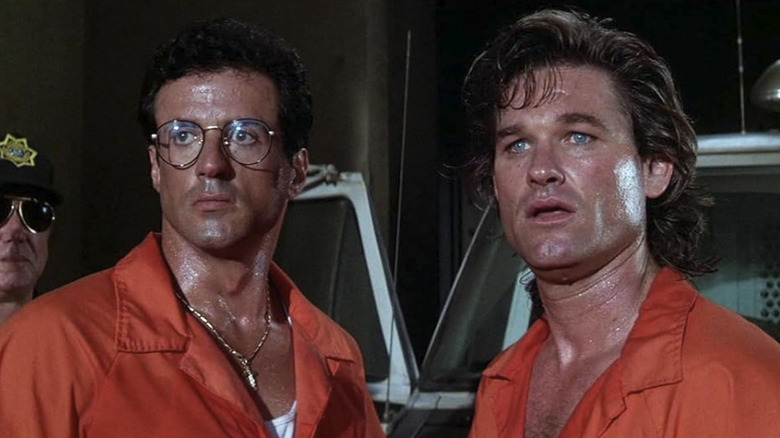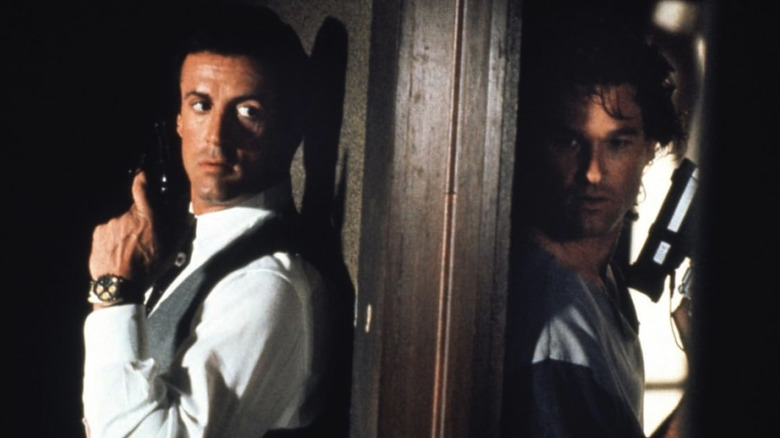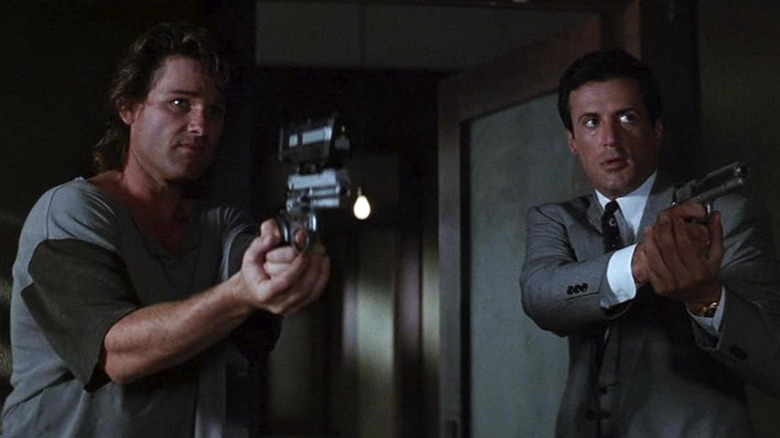A Kurt Russell And Sylvester Stallone Crime Movie Was Shot By Three Different Directors
The 1989 buddy cop movie "Tango & Cash" is a weird animal. Lieutenant Ray Tango (Sylvester Stallone) is the star cop of the LAPD's narcotics division on the Westside, while Lieutenant Gabriel Cash (Kurt Russell) is the star officer of the Eastside. People from Los Angeles know that these are vital distinctions. The two haven't ever met, but are both loathed by the criminal underworld, and are set up by drug dealers to take the fall for a drug bust gone wrong. Tango and Cash are pilloried in court, and end up together in a maximum security prison. To clear their names, they'll have to escape and track down the bad guys, including gangster Yves Perret, played by Jack Palance.
The story is broad and all over the place, and the tone is weirdly slapstick. "Tango & Cash" is as slick as 1980s cop movies come, but its sense of humor is weirdly caustic, and its script is terrible. Russell is a charming enough actor to handle this sort of lightweight brick-stupid actioner, but Stallone seems weirdly lost. The pair have no chemistry. "Tango & Cash" wasn't beloved when it came out, and it currently sports a 31% approval rating on Rotten Tomatoes. It was nominated for three Razzies. Weirdly enough, the film was an okay hit, making over $120 million on a $54 million budget.
The film's scattershot tone may easily be attributable to the fact that three directors had to take turns helming it. The bulk of "Tango & Cash" was overseen by Andrei Konchalovsky, the screenwriter of Tarkovsky's "Andrei Rublev" and "Ivan's Childhood," and the director of "Runaway Train." Konchalovsky, however, was fired by producer Jon Peters after three months of shooting. It seems they butted heads over the film's ending. The story of the film's making has been catalogued by The Dissolve.
Tango & Cash had three directors
The troubled production of "Tango & Cash" was common knowledge, even at the time. A report from The Los Angeles Times, published in November of 1989, pointed out that the various script re-writes, director changes, and other scheduling problems forced the budget of the film way higher than expected. It also being filmed in the middle of a lawsuit; Sony and Warner Bros. were arguing over who had actual control over Guber-Peters Entertainment, Jon Peters' production company.
And, golly, the personnel changes this flick underwent. Konchalovsky was fired partly for creative differences, but also because of the ballooning budget. He was replaced by Albert Magnoli, the director of "Purple Rain" and several other projects for Prince. Not mentioned in the Times article is the fact that the second unit director for "Tango & Cash" — and, curiously, also an executive producer — Peter MacDonald was brought for a few weeks to direct before Magnoli could start in earnest. Stallone trusted MacDonald, though, as he directed "Rambo III" the previous year. (MacDonald would go on to make "The NeverEnding Story III: Escape from Fantasia," which starred a young Jack Black.) Although Konchalovsky was the only credited director, "Tango & Cash" had three. And because Stallone was pushing so hard to control various aspects of production, one might even consider him an unofficial fourth director.
Case in point: In The Dissolve article, it's pointed out that the film's original cinematographer, Barry Sonnenfeld, was fired by Sylvester Stallone for not lighting him in the way the actor preferred. Sonnenfeld was replaced after one week by Donald E. Thorin, who shot "Purple Rain" for Magnoli.
This was all in the shadow of constant re-writes. Randy Feldman is the only credited screenwriter, but the script changed hands many, many times.
Stuart Baird might be the true hero of Tango & Cash
One of the screenwriters who was hired to re-write the "Tango & Cash" script was Jeffrey Boam, and he has said in interviews (notably, with The Occasional Critic in 2012) that he hated his work on the movie, and was glad not to have been credited.
No one can say which of the directors made the film so weirdly erotic. There is a bare-butt prison shower scene in "Tango & Cash" that seems like a remnant left over from a 1970s women-in-prison grindhouse flick, as well as a scene wherein Russell and Stallone are caught in tiny white tank tops in the pouring rain. Then, for good measure, Russell has a scene where he dresses in drag to elude police capture. Eroticizing men's bodies was common enough in the 1980s (see: "Top Gun"), but it seems to be on a particularly intense level here.
Then, on top of all that, the film's poor beleaguered editor, Stuart Baird, had to cobble together something vaguely coherent from all the various directors' footage. Baird may be the true hero of "Tango & Cash," as he managed to make a film that, while weird and wild, is at least baseline coherent. Baird is one of three credited editors on the film, having replaced Robert A. Ferretti and hired Hubert C. de la Bouillerie to join him. Baird was also the one who hired composers Harold Faltermeyer and Gary Chang to re-do the film's score.
Baird would eventually start directing films of his own, including "Executive Decision," "U.S. Marshals," and "Star Trek: Nemesis." He also continues to edit high-profile action movies. Let's give the man his proper props.
Stallone, meanwhile, wants a "Tango & Cash 2." No one else does.


